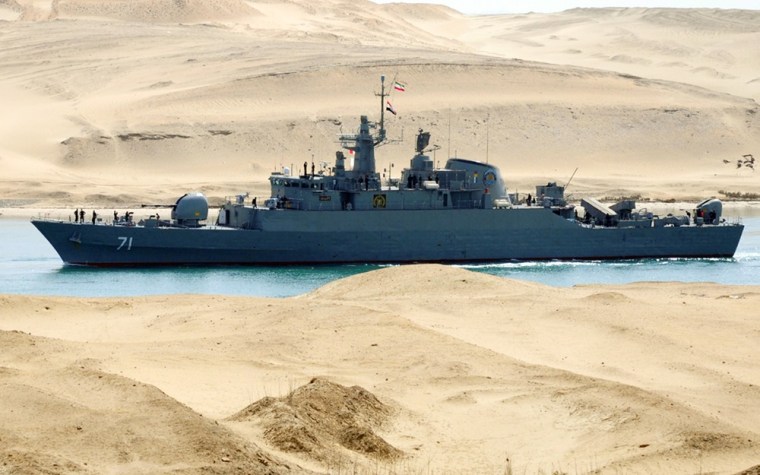Iran has never been shy about claiming military advances such as missiles capable of hitting Israel or an attack drone dubbed the "ambassador of death." Its latest focus: The high seas.
In the past week, Iran has announced the deployment of ship-based missiles that can target shorelines from international waters, and its naval commander said that Islamic Republic warships could someday be cruising near America's Atlantic seaboard.
While many defense analysts believe such a mission is still far beyond Iran's naval reach, the current emphasis on maritime forces suggests a growing drive by Tehran to display power beyond the Gulf and the overwhelming presence right on its doorstep of the U.S. Navy's 5th Fleet.
"Iran simply doesn't have the ability to be a naval giant at this point," said Theodore Karasik, a security expert at the Dubai-based Institute for Near East and Gulf Military Analysis. "That doesn't mean, however, Iran is not serious about trying to move in that direction."
Warships flying the Iranian flag already have been sent far beyond the Gulf.
In February, two Iranian navy vessels passed through the Suez Canal and into the Mediterranean for the first time since the 1979 Islamic Revolution, raising alarm from archfoe Israel. Iranian ships also have been sent to challenge Somali pirates off the Horn of Africa.
In June, Iran said it sent submarines to the Red Sea in the first such deployment outside the Gulf.
The next step is dispatching warships to cruise in international waters off the U.S. East Coast, said Iran's navy chief, Rear Adm. Habilbollah Sayyari.
"In the same way that the 'world arrogance' is present near our sea borders, we will have a powerful presence near the U.S. sea borders," Sayyari said last week, using one of Iran's mocking phrases to describe the U.S.
Sayyari gave no timetable on a possible Atlantic mission. But many military analysts view it as more bluster than reality given Iran's current naval fleet, which suffered blows in Gulf battles during the 1980-88 Iran-Iraq war.
Iran's current navy has a few frigate-class vessels that can move beyond the Gulf but largely comprises much smaller attack and patrol craft that need to remain close to shore.
The website of Iranian state TV quoted Sayyari on Monday as saying that Iran's "presence in the open seas" is supported by Supreme Leader Ayatollah Ali Khamenei, who has final say on all state matters.
"The Atlantic Ocean is one of the open seas and we can have a presence there and in other open seas around the world. We will definitely do that," Sayyari was quoted as saying.
In Washington, White House spokesman Jay Carney responded to Iran's Atlantic warnings by saying the U.S. doesn't "take these statements seriously ... given that they do not reflect at all Iran's naval capabilities."
But Iran is not short on ambition — or at least boasts about its purported military developments.
During war games in July, Iran unveiled underground missile silos it claims can withstand a direct bomb strike. Iran says it already has missiles with ranges of up to 1,240 miles (2,000 kilometers), putting Israel, U.S. bases in the Gulf and parts of Europe within reach.
The missiles are one of the showpieces in Iran's self-described strides toward homegrown expertise in technology — including military arsenals, equipment to create nuclear fuel and rockets capable of putting satellites in orbit.
Part of the drive for self-reliance in engineering is a way to ridicule Western-led sanctions over Iran's nuclear program, which the U.S. and others fear could lead to atomic weapons. Iran says it only seeks energy and medical research from its reactors, including a Russian-built plant that began producing electricity last month.
But Iran's push for military self-sufficiency also springs from necessity. U.N. arms embargoes on Iran sharply limit its access to new technology and have forced military planners to retool existing equipment — some dating from the 1970s or earlier — or attempt to master their own designs.
"Even if Iran wants to try to improve its conventional military capability in the next few years and has the money to do so, the U.N. arms ban will make that close to impossible," wrote Bruce Riedel, a military affairs researcher at the Brookings Institution in Washington.
Iran, however, tries to present a much more confident picture.
The country's defense minister, Gen. Ahmad Vahidi, said last week that factories are now mass producing a ship-based missile with a range of 125 miles (200 kilometers) to hit "warships and coastal targets." The missile was unveiled last month by President Mahmoud Ahmadinejad, who claimed it was built entirely by Iranian technicians.
Last year, Iran announced its first domestically built guided-missile destroyer, Jamaran, which it said can carry attack helicopters.
The official news agency IRNA also quoted the head of naval research, Mansour Maghsoudlou, as saying new submarines are on the drawing board, but the report gave no other details.
"Iran's trip to the Suez was mostly symbolic. The eastern Mediterranean is about the limit of their naval capabilities at this stage," said Paul Rogers, a professor at Bradford University in Britain and a frequent commentator on security affairs. "But that probably won't stop Iran from speaking loudly about their plans on the seas, which seem less about what they can really do and more for political purposes."
